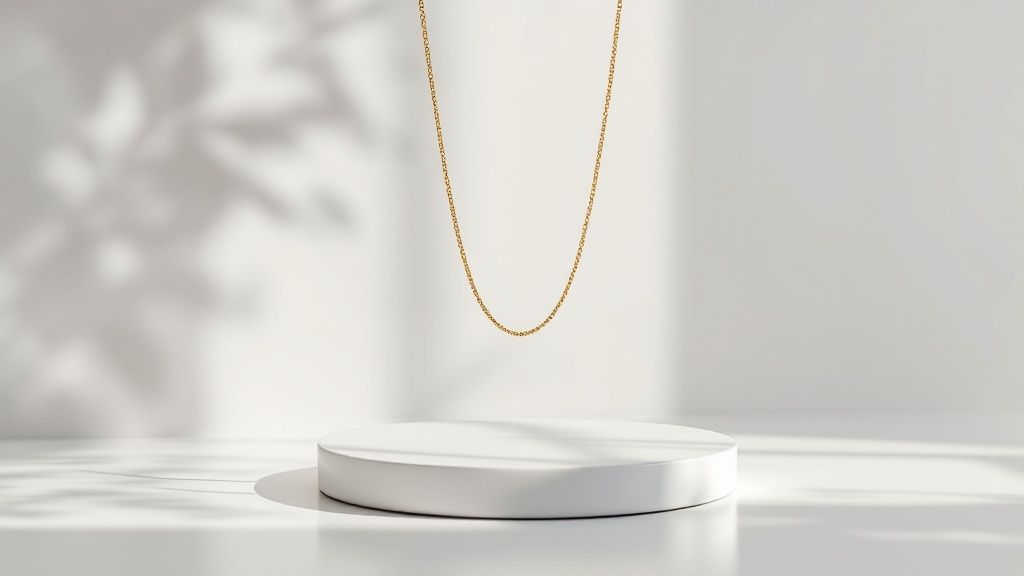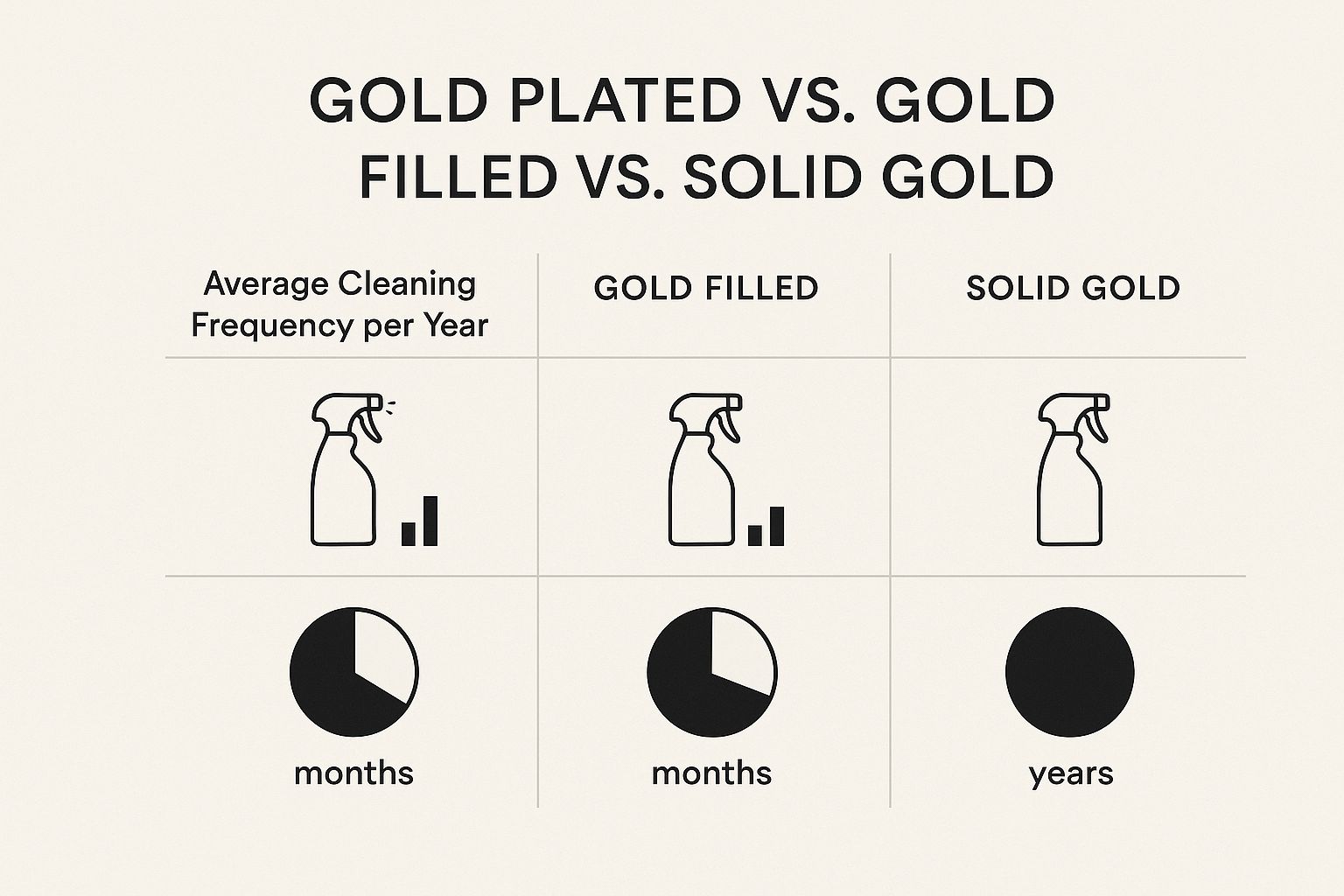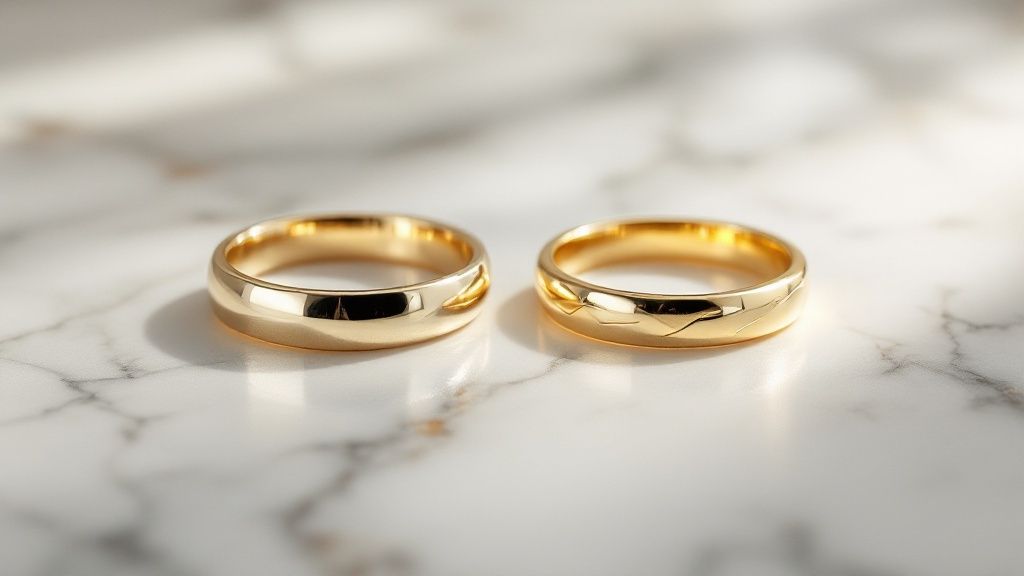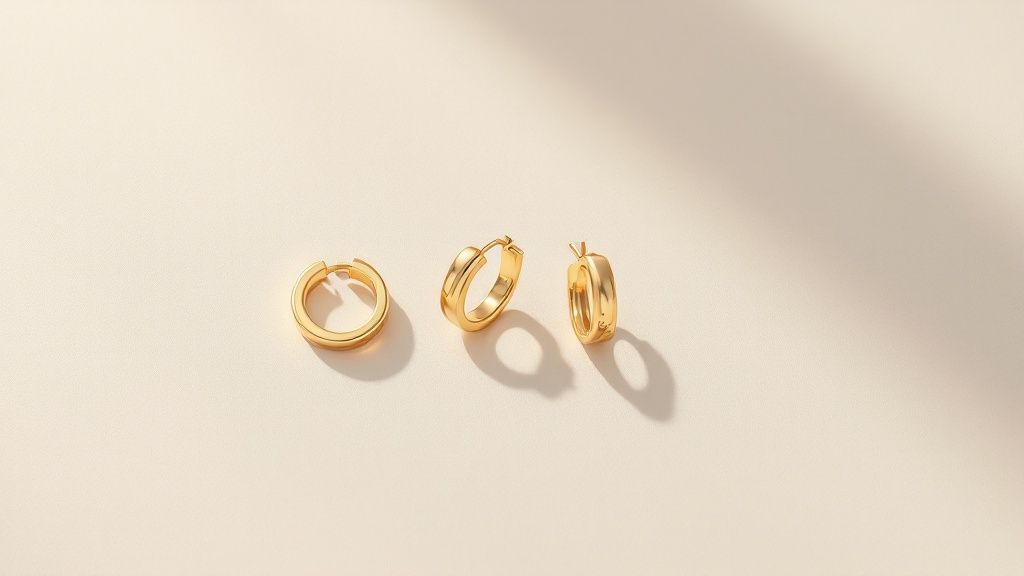Arthur Lynch | Fri Sep 05 2025
Your Guide to Gold Plated Jewelry
Gold plated jewelry is the secret to getting that solid gold look without the hefty price tag. It’s a smart way to craft beautiful, budget-friendly pieces by bonding a genuine layer of gold over a more affordable base metal, like brass or sterling silver.
This approach makes gold plating perfect for anyone who loves keeping their style fresh and building a versatile jewelry collection.
What Is Gold Plated Jewelry, Really?

The best way to think about gold plated jewelry is to imagine a beautiful, high-quality finish on a solid, reliable core. The core—or base metal—is chosen for its strength and affordability. The finish is a real layer of gold, which gives the piece its brilliant, luxurious shine.
The biggest draw, of course, is the price. Solid gold is a serious investment, which isn't always practical if you love to keep up with fast-moving trends. With gold plated pieces, you can dive into the latest styles—from the chunky hoops trending in Western markets to the delicate layered chains popular across Asia—without breaking the bank.
The Appeal of Accessible Luxury
This method of making jewelry unlocks endless design potential. It allows creators to produce bold, intricate, and fashion-forward accessories that have all the flair of high-end jewelry. The real value is getting that luxury look and feel for a fraction of the cost.
This affordability gives you the freedom to:
- Build a diverse collection that you can switch up with the seasons.
- Experiment with global trends without the major financial commitment of solid gold.
- Travel without worry, leaving your irreplaceable solid gold pieces safely at home.
It's also good to know that not all plating is created equal. For instance, you'll often hear about vermeil, which is a premium type of plating that uses a thicker layer of gold over a sterling silver base. To get the full story on this higher-quality option, check out our guide on https://www.jewelrybuydirect.com/articles/what-is-vermeil-jewelry.
Once you understand the simple but brilliant process behind gold plated jewelry, you start to see the real artistry and value it offers. It’s not about imitation; it’s about making elegant style accessible to everyone.
The Science Behind a Lasting Shine
Creating that perfect, luminous gold finish is really a fascinating mix of chemistry and engineering. The most common way to make gold plated jewelry is a process called electroplating, and the science behind it is surprisingly straightforward.
Think of it this way: you start with a base metal, like a piece of brass or sterling silver. This piece is dipped into a special chemical solution that's filled with tiny, positively charged gold particles. When an electric current is passed through the bath, the base metal becomes negatively charged, acting like a magnet that pulls those gold particles onto its surface, creating a thin, even layer.
This whole process is about control. The thickness of the gold layer—and ultimately, the piece's durability and color—depends entirely on how long it stays in the solution and the strength of the current. It’s this precision that turns a simple base metal into something that looks and feels luxurious.
Modern Plating Technologies
While electroplating is the tried-and-true method, things are always evolving. One of the most durable techniques you'll see today is called Physical Vapor Deposition, or PVD. This is a much more high-tech process where, inside a vacuum chamber, solid gold is vaporized and then deposited, molecule by molecule, onto the base metal.
The PVD method creates an incredibly strong and uniform bond. The resulting gold layer is far more resistant to scratches, corrosion, and general wear and tear than most traditional plating. It's why you often see PVD used for things that take a beating, like high-end watches, ensuring that brilliant gold finish lasts for years, not months.
Understanding these plating methods is key for any buyer. It demystifies why one gold plated necklace might cost more or last longer than another—it’s not magic, just better science and a higher quality application.
This kind of manufacturing precision has built a huge global industry. In fact, the market for the gold plating chemicals alone was valued at over $522 million and is expected to climb to nearly $815 million. That boom is a direct reflection of our growing appetite for accessible, high-quality jewelry. You can dig into the numbers yourself by checking out the gold plating chemicals market research at PrecedenceResearch.com.
Knowing the difference between these techniques helps you shop smarter. If you're buying a trendy piece for a season or two, standard electroplating is a perfectly good, budget-friendly choice. But if you're looking for an everyday staple like a ring or bracelet you'll never take off, investing in a piece made with PVD will pay off in the long run, keeping your favorite gold plated jewelry looking great through the rigors of daily life.
How to Identify High-Quality Pieces
When you're shopping for gold plated jewelry, it can be tough to tell what's a cheap and cheerful piece versus a well-made treasure that will last. It really comes down to two things: how thick the gold layer is and what metal is hiding underneath.
Think of the gold plating like a coat of paint on a house. A thin, quick coat will start chipping and fading fast. A thick, well-applied one will stand up to the elements for years. In jewelry, we measure that thickness in microns—one-millionth of a meter.
For a piece you want to wear regularly, look for at least 1.0 micron of gold. Anything less than that (often called "gold flashed" and typically under 0.5 microns) is really only suitable for earrings or a necklace you might wear to a single event. For rings and bracelets that see a lot of action, you'll want something much thicker. Aim for 2.5 microns or more, which is the standard for gold vermeil (when plated over sterling silver).

Look Beyond the Gold Layer
The metal at the core of the jewelry is just as important as the gold on top. A weak foundation will doom the piece, no matter how shiny it looks at first. The base metal affects the item’s weight, durability, and whether it will irritate your skin.
Your best bets for base metals are brass and sterling silver.
- Brass: This alloy of copper and zinc is a real workhorse. It’s strong, resists corrosion, and gives the jewelry a satisfying heft. It's an excellent and affordable foundation that holds onto gold plating extremely well.
- Sterling Silver: When a piece is plated over sterling silver, it's called gold vermeil. You’re getting a precious metal on top of another precious metal, which adds real value and makes it a great choice for sensitive skin.
Cheaper base metals, like zinc or nickel alloys, are more likely to cause a skin reaction if the gold layer eventually wears away. It’s always worth investing in a better core.
The secret to buying quality gold plated jewelry is to think like an inspector. You're not just looking at the gold finish; you're assessing the entire structure, from its core material to the final polish.
To help you sort through the options, we've put together a simple comparison table. This breaks down the common types of gold plating you'll encounter and what to expect from each.
Gold Plated Quality Comparison Guide
| Plating Type | Gold Thickness (Microns) | Common Base Metal | Durability & Lifespan | Price Point |
|---|---|---|---|---|
| Gold Flashed/Washed | < 0.5 microns | Zinc, Nickel, Copper | Very Low (months) | $ |
| Standard Gold Plated | 0.5 - 1.0 microns | Brass, Stainless Steel | Low to Medium (1-2 years) | $$ |
| Heavy Gold Plated | 1.0 - 2.5 microns | Brass, Stainless Steel | Medium (2-4 years) | $$$ |
| Gold Vermeil | 2.5+ microns | Sterling Silver | High (5+ years) | $$$$ |
This guide shows how a thicker gold layer and a better base metal directly translate to a longer-lasting and more valuable piece of jewelry.
Your Quality Checklist
Before you buy, run through this quick mental checklist. The small details are often the biggest giveaways about the true level of craftsmanship.
- Check for Stamps: Turn the piece over and look for small markings. "GP" means gold plated, while "925" or "Sterling" tells you the base is sterling silver. These stamps show the maker isn't hiding anything.
- Examine the Finish: High-quality plating should look like liquid gold—perfectly smooth, even, and consistent. Check for any dark spots, patchiness, or bubbling, especially around the tricky areas like clasps and joints.
- Assess the Weight: Does it feel substantial in your hand? A piece with some heft usually points to a quality base metal like brass or silver. If it feels feather-light and flimsy, it's likely made from a cheaper alloy.
- Confirm the Thickness: Don't be shy! Ask the seller or check the product description for the plating thickness in microns. A good vendor will know this information and share it proudly for their gold plated jewelry.
What’s Trending in Gold Plated Fashion Around the World?

Fashion never stands still, and gold plated jewelry's affordability allows designers and consumers to instantly adapt to new styles. This is why it’s a major force behind today's global accessory trends, from minimalist staples to bold, vintage-inspired statement pieces.
Global Trends to Watch and Stock
For retailers and fashion enthusiasts alike, staying ahead means knowing which styles have global appeal. These trends in gold plated jewelry are currently dominating runways, social media, and street style worldwide.
- Bold Chains & Links: Chunky, oversized chains—from paperclip to curb and rope styles—are in high demand. This trend leans into a maximalist aesthetic, with heavy necklaces and bracelets serving as the focal point of an outfit.
- Sculptural & Organic Shapes: Jewelry inspired by nature and modern art is booming. Look for earrings, rings, and pendants with fluid, abstract, or molten metal designs that feel unique and handcrafted.
- Modern Pearls: Pearls have shed their traditional image. Today's trend combines them with modern gold elements, such as baroque pearls hanging from chunky gold hoops or interspersed on delicate chains.
- Personalized Charms & Medallions: Customization remains a powerful driver. Zodiac signs, initials, and meaningful medallions allow consumers to create a personal narrative with their accessories, making these items top sellers.
Regional Tastes: How to Adapt Your Collection
While the above trends are global, understanding regional preferences is key to capturing specific markets. Here’s a breakdown of current fashion nuances:
- North America & Europe: Consumers here embrace both minimalism and maximalism. There is strong demand for delicate, everyday layered necklaces and stackable rings alongside bold, sculptural statement pieces. Brands focusing on clean lines and modern aesthetics perform very well.
- Asia-Pacific: In markets like India, China, and South Korea, there is a strong preference for rich, yellow gold tones. While delicate K-fashion styles (thin chains, small charms) are popular, there is also a deep appreciation for more intricate, ornate designs that reflect cultural heritage, often featuring gemstones and detailed metalwork.
- Middle East: Consumers often favor luxurious, high-impact jewelry. Layering multiple intricate chains, statement rings, and elaborate earrings is common. Rich gold tones are paramount, and designs often incorporate traditional motifs and calligraphy.
- Latin America: Bright, vibrant styles are popular. Jewelry often features bold colors, natural stones, and floral or animal motifs. Hoops of all sizes are a perennial favorite, and there's a strong market for eye-catching, festive pieces.
The global gold-plated jewelry market is growing consistently, driven by the demand for accessible luxury. Experts forecast a steady annual growth rate between 5.6% and 6.1%. Interestingly, rings tend to see a huge spike in popularity during the holiday season. You can dive deeper into the growth of the gold-plated jewelry market on accio.com.
By understanding both global megatrends and regional tastes, you can curate a collection of gold plated jewelry that feels both current and culturally relevant.
How to Care For Your Gold Plated Jewelry
The secret to keeping your favorite gold plated jewelry looking brilliant for years isn't just about how it was made—it's about how you treat it every day. That delicate layer of gold is beautiful but not invincible. A little mindfulness in your daily routine is all it takes to protect it from premature wear and tear.
Think of it this way: your jewelry should always be the "last on, first off." It’s the finishing touch after you’ve applied all your lotions, perfumes, makeup, and hairspray. Those products contain chemicals that can slowly eat away at the gold finish. Likewise, it should be the first thing you remove before you shower, change clothes, or head to bed.
Simple Steps for Cleaning and Maintenance
Regular, gentle cleaning is your best friend. It washes away the day's accumulation of skin oils, sweat, and grime that can make your pieces look dull. Whatever you do, steer clear of harsh chemicals or abrasive scrubbers; they'll strip that thin gold layer right off.
Instead, stick to this simple cleaning ritual:
- Mix a Gentle Bath: Add just a few drops of a mild, non-detergent soap (basic dish soap works great) to a small bowl of lukewarm water.
- Give It a Quick Soak: Let your jewelry sit in the solution for a few minutes. You don't want to leave it for too long, as prolonged exposure to water isn't ideal.
- Use a Soft Touch: Gently clean the piece with a super soft-bristled brush—a baby toothbrush is perfect—or even just your fingertips.
- Rinse and Dry Completely: Run the jewelry under some cool water to rinse off the soap, then pat it completely dry with a soft, lint-free cloth. Any trapped moisture can cause tarnishing.
Proper care is all about prevention. Just think of that gold layer as a delicate shield. Your job is to keep that shield intact by protecting it from friction, moisture, and harsh chemicals.
Smart Storage and Daily Habits
Where you keep your jewelry when you're not wearing it matters just as much as how you clean it. Tossing everything into a single drawer is a surefire way to get scratches, tangles, and worn-off plating.
- Store Separately: Give each piece its own home, whether that's a soft pouch or a separate compartment in a lined jewelry box. This stops your pieces from rubbing and scratching against each other.
- Avoid Extreme Conditions: Always take off your jewelry before you go swimming (chlorine is a killer for plating), hit the gym (sweat is acidic), or tackle household chores.
Embracing these habits is more important than ever, given how massive this market has become. The global jewelry market is valued at roughly $366.79 billion, and costume jewelry—where gold plated jewelry shines—accounts for a huge $77 billion of that. With the Asia-Pacific region driving nearly 40% of market revenue, the demand for beautiful, long-lasting pieces is only growing. You can dive deeper into the global jewelry market trends at CaratTrade.com.
Sourcing and Buying Jewelry Wholesale

For anyone looking to start a jewelry business, finding the right source for gold plated jewelry is one of the most important first steps. Buying wholesale is how you get inventory at a price that allows for a healthy profit margin, but the real challenge is finding manufacturers you can count on for consistent quality.
So, where do you start? The search often begins on B2B online marketplaces, which are essentially a global directory of suppliers right at your fingertips. Industry trade shows are another gold mine; they give you the invaluable chance to see and feel the jewelry in person and connect face-to-face with potential vendors.
Vetting Your Wholesale Partners
Once you've got a shortlist of suppliers, the real work begins. This is the crucial vetting stage where you'll separate the reliable, long-term partners from those who might cause headaches down the road. It’s tempting to focus solely on the lowest price, but remember that quality, dependability, and ethical practices are what will ultimately protect your brand's reputation.
To make sure you’re choosing the right supplier, here are a few non-negotiable steps:
- Request Samples: Never skip this. You absolutely must see and handle the pieces yourself to judge the plating quality, the feel of the base metal, and the overall craftsmanship before you even think about a bulk order.
- Discuss MOQs: Get a clear understanding of their Minimum Order Quantities (MOQs) and how their pricing changes with volume. This is key to managing your cash flow and inventory.
- Verify Ethical Standards: Don't be shy about asking how their jewelry is made and where their materials come from. A supplier who is open and transparent about their process is always a better bet for the long haul.
The goal of sourcing is to build a reliable supply chain. A great wholesale partner doesn't just sell you products; they provide the quality and consistency you need to build customer trust and grow your business.
Keep in mind that different jewelry types have different supply networks. If you're looking to offer pieces with greater durability, exploring options for gold filled wholesale jewelry could be a smart move, as it provides a step up from standard plating. A little due diligence upfront goes a long way in building an inventory of high-quality gold plated jewelry and steering clear of common sourcing pitfalls.
Answering Your Top Questions About Gold Plated Jewelry
Even after you get the basics down, a few questions about gold plated jewelry always seem to pop up. Let's tackle some of the most common ones so you can choose, wear, and care for your pieces like a pro.
Can I Wear Gold Plated Jewelry Every Day?
You can, but just know that daily wear is the fastest way to wear down that beautiful gold layer. Think about it—high-traffic pieces like rings and bracelets are constantly rubbing against desks, clothes, and everything else you touch.
If you want your jewelry to last, it's a good idea to save your plated pieces for occasions that don't involve a lot of rough contact. A simple rule of thumb is to take them off before you sleep, hop in the shower, or hit the gym. This little habit makes a huge difference in protecting the finish.
Does Gold Plated Jewelry Turn Your Skin Green?
It's a classic question, and the answer might surprise you. That dreaded green tint isn't from the gold at all. It’s actually the base metal, usually copper or brass, having a chemical reaction with the oils, sweat, and lotions on your skin.
Good news, though. A higher-quality, thicker plating acts as a much better shield between the base metal and your skin. Pieces made with a sterling silver base (gold vermeil) are even less likely to cause this issue. The best defense? Keep your jewelry clean and dry.
The lifespan of gold plated jewelry is a direct reflection of its quality and your care habits. A thicker plating and mindful wear can extend its shine for years.
How Long Does Gold Plating Last?
This is the million-dollar question, and the answer really boils down to three things: the thickness of the plating, the type of base metal, and how you treat the piece.
- Standard Fashion Jewelry: A thin plating, typically under 1 micron, might only keep its shine for a few months up to a year if you wear it often.
- Higher-Quality Plating: When you get into thicker plating or true gold vermeil (2.5+ microns), you're looking at a piece that can last for several years with the right care.
For anyone thinking about starting their own jewelry business, knowing the difference between these quality tiers is non-negotiable. If that sounds like you, you can dive deeper by reading our guide on how to sell jewelry online.
Ready to build a stunning collection of high-quality, trend-forward accessories? Explore the vast wholesale selection at JewelryBuyDirect and discover pieces that offer both style and value. Shop now at https://www.jewelrybuydirect.com.

 to show code
to show code






































































































































































